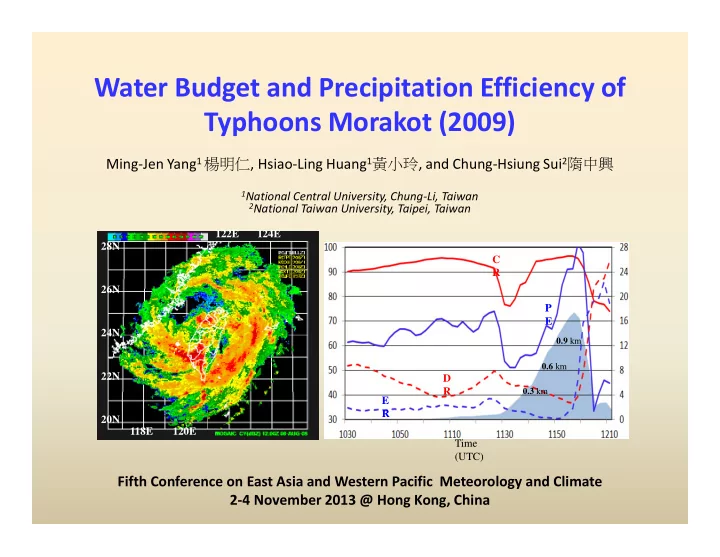

Water Budget and Precipitation Efficiency of Typhoons Morakot (2009) Ming-Jen Yang 1 楊明仁 , Hsiao-Ling Huang 1 黃小玲 , and Chung-Hsiung Sui 2 隋中興 1 National Central University, Chung-Li, Taiwan 2 National Taiwan University, Taipei, Taiwan 122E 124E 28N C R 26N P E 24N 0.9 km 0.6 km 22N D R 0.3 km E R 20N 118E 120E Time (UTC) Fifth Conference on East Asia and Western Pacific Meteorology and Climate 2-4 November 2013 @ Hong Kong, China
Purpose • To improve the understanding of the physical mechanisms producing the record-breaking rainfall (>2800 mm in 3 days) on Taiwan for Morakot (2009) from the viewpoint of changes of water budget and precipitation efficiency during the landfall process .
Budget Equations [from Yang et al. (2011;MWR )] Water vapor budget : q v Cloud budget : q c = q w + q i where is the total condensation and deposition; is the evaporation and sublimation; is the net horizontal flux convergence; is the vertical flux convergence; is the divergence term is the numerical diffusion is the boundary layer source and vertical (turbulent) diffusion is the residual term is the precipitation flux. CMPE (Cloud Microphysics Precipitation Efficiency; CMPE2, Sui et al. 2007):
WRF domain and physics for Morakot Simulation � 9/3/1 km (416x301 / 541x535/ 451x628) � 31 sigma ( σ ) levels � Two-way feedbacks � No CPS is used! � WRF Single-Moment 6-class scheme (WSM6) IC/BC: EC 1.125 � � lat/lon � Initial time: 0000 UTC, 6 Aug 2009 � Integration length: 96 h
Tracks from the CWB (OBS) and WRF (CTL/FLAT) OBS SL CTL P (hP a) FLAT Time (UTC)
���� ���� ���� ���� 08/08/11 UTC ��� OBS @ CWB CTL ��� ���� ���� ��� ��� ��� ��� ��� ��� ��� ��� ��� ��� ���� ���� ��� ��� FLAT ���
CWB: mm OBS Day1 Day2 Day3 WRF: CTL
CWB: mm OBS Day1 Day2 Day3 WRF: FLAT
72-h Rainfall (08/07/00 ~ 08/10/00 UTC) CWB_OBS WRF_CTL WRF_FLAT mm 2323 3392 2683 2477 3847
(mm h -1 ) FLAT CTL Run Rainrate (mm h -1 ) Efficiency (%) Time
Rainrate (mm h -1 ) Efficiency (%) Ef fic ie nc y ( % ) Liquid/Ice Water Budget Water Vapor Budget Time (UTC)
Further decomposition of microphysical parameters into three components Condensation Ratio : Deposition Ratio: Evaporation Ratio : where is the total condensation and deposition; is the cloud water condensation; is the snow deposition; is the graupel deposition; is the cloud ice deposition; is the raindrop evaporation
Lagrangian evolution of microphysical parameters CR PE Efficiency 1 (%) Cell A Efficiency 2 (%) 0.9 km 0.6 km DR 0.3 km ER Time (UTC) CR Efficiency 1 (%) Efficiency 2 (%) PE Cell B 1.2 km 0.9 km 0.6 km DR 0.3 km ER Time (UTC)
Lagrangian evolution of microphysical parameters CR Efficiency 1 (%) PE Cell C Efficiency 2 (%) 0.6 km DR 0.3 km ER Time (UTC) CR Efficiency 1 (%) Efficiency 2 (%) PE Cell D ER 0.6 km DR 0.3 km Time (UTC)
Eulerian evolution of microphysical parameters In two time-and-space-averaged cross sections CR Efficiency 1 (%) Efficiency 2 (%) DR PE Cross Section A 1.2 km ER 0.8 km 0.4 km Longitude CR Efficiency 2 (%) Efficiency 1 (%) Cross Section B PE DR 0.8 km 0.4 km ER Longitude
Conclusions • The 1-km WRF run reproduced resonably well the Morakot track, the organization, the sizes of eye and eyewall, major convective cells on outer rainbands, and rainfall maxima on southwestern Taiwan. • The surface rainrate (36-54 mm/h) and PE (75-100%) over southwest Taiwan are highly correlated. • The surface rainrate and PE of the no-terrain run are only 50% and 15- 20% less than those of full-terrain run. • By following the movement of major convective cells, PEs are 60-75% over ocean and > 95% above terrain. • The Lagrangian evolution of major cells shows that PE and CR are increased on the windward slope but decreased on the lee side; the reverse trend is found for the DR and ER. • The Lagrangian evolution is also confirmed by the changes of microphysical parameters across the mountains in two time-and-space- averaged cross sections in an Eulerian framework. Reference: Huang, H.-L., M.-J. Yang *, and C.-H. Sui, 2013: Water budget and precipitation efficiency of Typhoon Morakot (2009). J. Atmos. Sci. , doi:10.1175/JAS-D-13-053.1, in press.
Introduction • Morakot’s landfall on Taiwan occurred concurrently with the southwesterly monsoonal flow, very slow movement and the continuous formation of mesoscale convection. (Chien and Kuo 2011; TAO) • The terrain of Taiwan strongly determines the Morridakot rainfall distribution at the time of landfall. (Fang et al. 2011 in WAF; Huang et al. 2011 and Yen et al. 2011 in TAO) • PE (Precipitation Efficiency) was used to predict rainfall from grid- scale vapor convergence in operational model forecasts (Doswell et al. 1996; Auer and Marwitz 1968; Heymsfield and Schotz 1985; Chong and Hauser 1989; Li et al. 2002a; Tao et al. 2004; Sui et al. 2005). • Yang et al. (2011; MWR) investigates the evolution of the water vapor, cloud, and precipitation budgets of Nari (2001) prio to and after landfall on Taiwan. • The water budget study may help us to understand the physical mechanisms producing the heavy rainfall on Taiwan for Morakot, and improve the microphysical parameterization for TCs in the future.
Oceanic Stage (0000 ~ 0100 UTC 7 August 2009) Water Vapor Budget: Liquid/Ice Water Budget:
Landfall Stage (00730 ~ 0830 UTC 8 August 2009) Water Vapor Budget: Liquid/Ice Water Budget:
Gravity Waves on the Lee Side (vertical velocity: colored; hydrometeor mixing ratio: contoured)
Recommend
More recommend